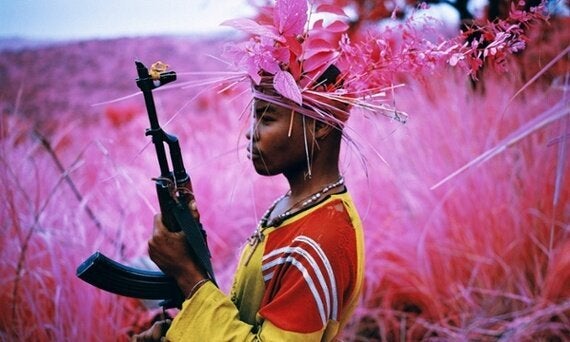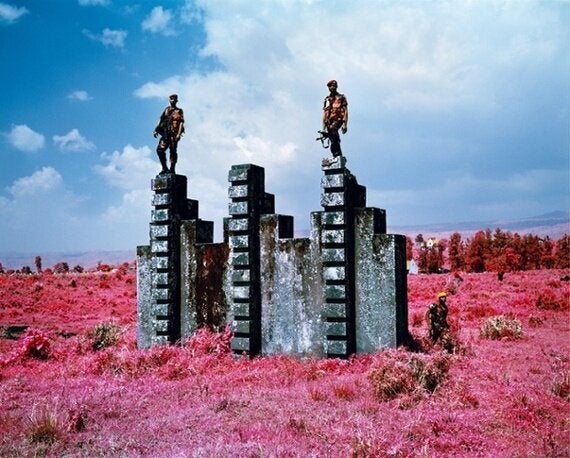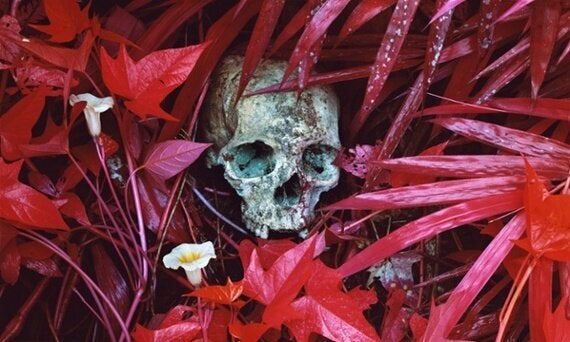
Safe From Harm, 2012 © Richard Mosse
How should scenes of human suffering and hardship be presented in a way that is ethical and considerate, yet also striking and thought-provoking? The great war photographers like Robert Capa and Eddie Adams achieved this with iconic images that defined generations, but then, they didn't live in a world where over one billion photos are shared each day. Gone is the era when photojournalists hold a monopoly on what we can see; no longer do their photographs hold a cherished position in our day, due to the glut of imagery they have to contend with.
For many, the issue is not resolved by allowing war photography to become aestheticised. French photojournalist Luc Delahaye was widely criticised for mixing reportage with art in his large-format photographs, which depicted recently-bombed landscapes and refugee camps - amongst other tragic subjects - in painterly style. But, for Irish photographer Richard Mosse, the flaw in war photography is that "it's always been very de-aestheticised, very black and white, grainy and gritty." People have become de-sensisitised to the daily news of death.
"Photographers have hidden the potential of the medium. They've been unwilling to really explore the medium, for very sound reasons: ethically." Mosse told the Australian national public broadcaster, ABC, last month. "They don't want to be seen to engage the landscape of human suffering with beauty."

Triumph Of The Will, 2012 © Richard Mosse
Yet, that is certainly a way you could describe Mosse's installation, The Enclave, which won the Deustche Börse Photography Prize 2014 in London this week. He made several trips to eastern Democratic Republic of Congo between 2010 and 2011, photographing the region's turmoil and the deadly Congolese M23 militia that caused it. But it was Mosse's decision to use Kodak Aerochrome, a discontinued infrared film that was originally used by the US army in World War II for camouflage detection, that makes the work so remarkable.
Due to the fact that infrared light is reflected in chlorophyll, the backdrops of his photographs become drenched in crimson or bathed in fuschia. Though since there is no chlorophyll in humans, skin tones - or in some cases, skulls - remain their usual colour in Mosse's work: war scenes are rendered in unfamiliar psychedelic hues, while the mundane humanity remains recognisable. Mosse's goal was to draw attention to the country's atrocities, which have been largely been unreported in the West. His project is lent even more poignancy when considering the fact that infrared light is invisible to the human eye: in a way, the artist is making visible an invisible conflict.
Disturbingly, this lack of media coverage in the West seems to correlate with the words supposedly uttered by Stalin: "A single death is a tragedy; a million deaths is a statistic." Since 1998, 5.4 million people have died as a result of the war in the Democratic Republic of Congo, while at least 400,000 women were raped over a 12-month period in 2006 and 2007, according to the American Journal of Public Health.

Of Lillies And Remains, 2012 © Richard Mosse
The success of Mosse's work exposes the shortcomings of other war photography and documentary photography today: much of it fails to overcome the widespread desensitisation of the viewing public. His undulating vermillion landscapes and conspicuous magenta figures are not rose-tinted depictions, so to speak: they do not make light of the grave situation. Rather, they work to denaturalise these quotidien images of brutality that we have largely become inured to.
Brett Rogers, director of The Photographers' Gallery, where the Deutsche Börse Prize was held, opined: "[Mosse's photographs] open up new possibilities for story-telling and engagement with the subject of contemporary conflict." Richard Mosse may call himself an artist, but through these photographs, he challenges the boundary between advocate, journalist, and artist. It is a significant nuance that contemporary photography community must earn from and adapt to.
